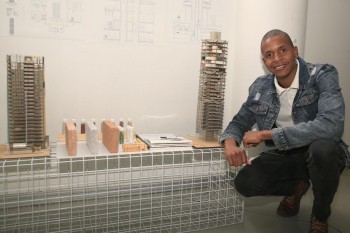Senzo Mamba (UJ) wins regional student architecture award.
Senzo Mamba from the University of Johannesburg was the regional winner of this sought-after award. Commenting on the Corobrik Architectural Student of the Year Award, Musa Shangase Corobrik Commercial Director said: “As an organisation, we believe that ‘better starts here’, and this is particularly true for this award. These up-and-coming young architects are already designing iconic structures that would imprint their legacy on the country’s built environment. It is truly an honour to witness history being made.”
For the Corobrik Regional Architecture Award, Senzo Mamba received R10 000, with Sibusiso Mncwango taking home the second prize of R8 000, and Tarien Laubscher receiving R6 000 for third place. A further R6 000 was awarded to Saikumar Singh for innovative use of clay masonry in the building design.
Senzo Mamba is one of eight young architects from top South African universities receiving a Corobrik Regional Architecture Award in recognition of their design talent and innovation throughout 2019. In addition to the cash prize, the regional competition winners are through to the finals of the National Architectural Student of the year Award – set to be announced in Johannesburg in May 2020 – which comes with R70 000 in prize money.
Bricolage: The architecture of waste
Senzo Mamba’s thesis is entitled ‘Bricolage: The architecture of waste’ He says, “In the natural world there is no landfill, instead material flow. One species waste is another’s food. Things grow and die nutrients return to the soil safely. The cycle circulates. Contrary, as human we have adopted a linear approach; we extract, we make, we use, and we dispose. A new product comes and we dispose of the old one. This model will simply not work long term. Construction and demolition industries are one of the largest waste generators. And a significant amount of this material ends up in landfills.”
“This project proposes turns vacant buildings to recycling factories as an alternative for dealing with waste issues within our cities, processing materials on site will reduce energy consumption, transportation and carbon foot print. This project aims to re-think waste by designing a catalogue of new material from it. Waste is not only a local resource but a natural material for practices of bricolage. Bricolage is the theory of make do with the tools and material that is available. Reclaiming, repurposing, and retrofitting vacant buildings is the first step towards a sustainable future.”
In second place Sibusiso Mncwango’s thesis is ‘Architecture of Occupation: An analysis of loopholes in policy’. Located in Cape Town CBD the project addresses inequality in Cape Town, specifically focusing on rentals within the CBD. Rentals range from R4 500 upwards are unaffordable to low-income earners working in the inner-city. Fortunately, in 2016 a social movement reclaimed an abandoned building to convert into accommodation for low-income people. Mncwango’s thesis attempts to extrapolate an affordable housing architectural form, representing protest architecture as a strategy for advocating for affordable housing in Cape Town.
Tarien Laubscher questioned South African heritage in her thesis entitled Kintsugi Concrete: Remaking problematic architectural heritage
She says that Johannesburg is a city filled with buildings from a troubled past, almost exclusively cast in reinforced concrete. By exploring alternative methods of material manipulation, we can drive to develop new ways of creating mixtures and methods of material grading that moves away from the traditional. And through material application and innovation change how we perceive these structures.
The best use of clay was awarded to Saikumar Singh for his Temple of the Sacred and Profane. The project aims to create meaning over the time it takes to construct a building. Meaning created through the construction process in this case 30 years. The temple will be constructed by a community of ordained temple builders from India who will reside onsite for the duration of the project. Temple builders will procure materials and make clay bricks for construction. It proposes that using and making clay bricks out of the soil available on site speaks more purely to the meaning of a building in relation to its context.
Shangase added that it was “Enlightening to see a generation of new architects showcasing world-class design talent. The designs by the winners of Corobrik Regional Architecture Award are an example of the start of legacy-enduring structures that will connect future generations with our current-day experiences. When it comes to creating a legacy in architecture, it’s best to rely on honest, simple materials that inform the architectural language without overpowering the finished product.”.
He concluded that “Corobrik’s clay brick range is a really impactful example of this, linking our past to our present and inspiring our future. Better starts here - with Corobrik.”


